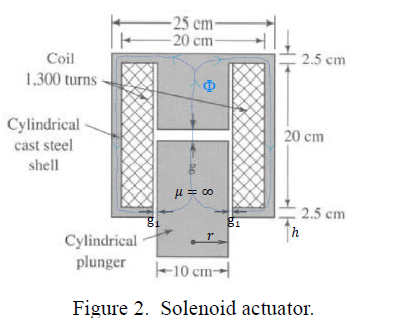Figure 2 shows a cylindrical iron-clad solenoid actuator which is used for tripping circuit breakers. When the coil current is zero, the plunger drops against a stop such that the gap g is 2.25 cm. When the coil is energized by a direct current of sufficiently large, the plunger is raised until it hits another stop set so that g is 0.2cm. The plunger is supported so that it can move freely in the vertical direction. The radial air gap g1 between the shell and the plunger can be assumed to be uniform and 0.05 cm in length. The exciting coil has 1300 turns and carries a constant current of 2.3 A. Assume that magnetic leakage and fringing in the air gaps and the MMF in the iron are negligible. Obtain the expressions for the flux density, coenery, and force acting on the plunger as a function of air gap length g, and determine the values of force on the
Figure 2 shows a cylindrical iron-clad solenoid actuator which is used for tripping circuit breakers. When the coil current is zero, the plunger drops against a stop such that the gap g is 2.25 cm. When the coil is energized by a direct current of sufficiently large, the plunger is raised until it hits another stop set so that g is 0.2cm. The plunger is supported so that it can move freely in the vertical direction. The radial air gap g1 between the shell and the plunger can be assumed to be uniform and 0.05 cm in length. The exciting coil has 1300 turns and carries a constant current of 2.3 A. Assume that magnetic leakage and fringing in the air gaps and the MMF in the iron are negligible. Obtain the expressions for the flux density, coenery, and force acting on the plunger as a function of air gap length g, and determine the values of force on the
Delmar's Standard Textbook Of Electricity
7th Edition
ISBN:9781337900348
Author:Stephen L. Herman
Publisher:Stephen L. Herman
Chapter29: Dc Generators
Section: Chapter Questions
Problem 1PA: You are working as an electrician in a large steel manufacturing plant, and you are in the process...
Related questions
Question
100%
solve the question
![Figure 2 shows a cylindrical iron-clad solenoid actuator which is used for tripping circuit breakers. When the coil current
is zero, the plunger drops against a stop such that the gap g is 2.25 cm. When the coil is energized by a direct current of
sufficiently large, the plunger is raised until it hits another stop set so that g is 0.2cm. The plunger is supported so that it
can move freely in the vertical direction. The radial air gap gı between the shell and the plunger can be assumed to be
uniform and 0.05 cm in length. The exciting coil has 1300 turns and carries a constant current of 2.3 A. Assume that
magnetic leakage and fringing in the air gaps and the MMF in the iron are negligible. Obtain the expressions for the flux
density, coenery, and force acting on the plunger as a function of air gap length g., and determine the values of force on the
plunger at g = 2.25 cm and g = 0.2 cm. P.S. The permeability of the free space is 4, = 4 • n • 10-7[H/m].](/v2/_next/image?url=https%3A%2F%2Fcontent.bartleby.com%2Fqna-images%2Fquestion%2Fca0755f2-d706-43d5-81ac-b585d14d7011%2F0ff665ea-72c9-48a0-bc9b-6396075575d0%2F2ikpvv_processed.png&w=3840&q=75)
Transcribed Image Text:Figure 2 shows a cylindrical iron-clad solenoid actuator which is used for tripping circuit breakers. When the coil current
is zero, the plunger drops against a stop such that the gap g is 2.25 cm. When the coil is energized by a direct current of
sufficiently large, the plunger is raised until it hits another stop set so that g is 0.2cm. The plunger is supported so that it
can move freely in the vertical direction. The radial air gap gı between the shell and the plunger can be assumed to be
uniform and 0.05 cm in length. The exciting coil has 1300 turns and carries a constant current of 2.3 A. Assume that
magnetic leakage and fringing in the air gaps and the MMF in the iron are negligible. Obtain the expressions for the flux
density, coenery, and force acting on the plunger as a function of air gap length g., and determine the values of force on the
plunger at g = 2.25 cm and g = 0.2 cm. P.S. The permeability of the free space is 4, = 4 • n • 10-7[H/m].

Transcribed Image Text:-25 cm-
-20 cm-
Coil
2.5 cm
1,300 turns
Cylindrical
cast steel
20 cm
shell
00 = 1
2.5 cm
Cylindrical
plunger
10 cm-
Figure 2. Solenoid actuator.
bo
Expert Solution
This question has been solved!
Explore an expertly crafted, step-by-step solution for a thorough understanding of key concepts.
This is a popular solution!
Trending now
This is a popular solution!
Step by step
Solved in 3 steps

Knowledge Booster
Learn more about
Need a deep-dive on the concept behind this application? Look no further. Learn more about this topic, electrical-engineering and related others by exploring similar questions and additional content below.Recommended textbooks for you

Delmar's Standard Textbook Of Electricity
Electrical Engineering
ISBN:
9781337900348
Author:
Stephen L. Herman
Publisher:
Cengage Learning

Delmar's Standard Textbook Of Electricity
Electrical Engineering
ISBN:
9781337900348
Author:
Stephen L. Herman
Publisher:
Cengage Learning